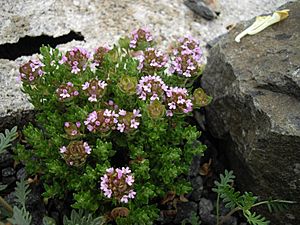Thymus camphoratus facts for kids
Quick facts for kids Thymus camphoratus |
|
|---|---|
 |
|
| Conservation status | |
| Scientific classification | |
| Genus: |
Thymus (plant)
|
| Species: |
camphoratus
|
| Synonyms | |
|
|
Thymus camphoratus, also known as Tomilho do Mar in Portuguese, is a special type of flowering plant. It belongs to the mint family, called Lamiaceae. This plant is found only in one specific area: southwest Portugal. This means it is endemic to that region.
What it Looks Like
Thymus camphoratus is a small, upright plant. It is a subshrub, which means it's like a small bush with woody stems at the bottom. It usually grows about 15 to 30 centimeters (6 to 12 inches) tall.
Stems and Leaves
The young stems of this plant have a square shape. They are covered with very short hairs. The leaves are small, about 6 to 8 millimeters long and 2 to 4.5 millimeters wide. They can be shaped like an egg or a diamond. The edges of the leaves are often rolled under, especially in the top half. The tips of the leaves are pointed or slightly blunt.
The underside of the leaves feels soft and whitish, like felt. The top surface can be smooth or slightly hairy. Both sides of the leaves have many tiny, round, yellowish glands. These glands might produce the plant's scent.
Flowers and Fruits
The flowers of Thymus camphoratus grow in a tight cluster at the top of the stem. This cluster is about 10 to 15 millimeters (0.4 to 0.6 inches) across. The special leaves around the flowers, called bracts, are wide and egg-shaped. They are often pale pink or reddish. These bracts are hairy and have clear veins.
Each flower has a cup-like structure called a calyx, which is about 4 to 6 millimeters long. The flowers themselves are about 5 to 8 millimeters long and can be pink or purple. They have a lower lip with large, almost equal parts. The plant also has purple anthers, which are the parts that hold pollen.
After the flowers, the plant produces small, dark brown fruits. These fruits are shaped like an oval and are very tiny, about 0.7 to 0.9 millimeters long.
Where it Grows
Thymus camphoratus is found only in the southwest part of Portugal. You can mostly see it in the Southwest Alentejo and Vicentine Coast Natural Park.
Its Home
This plant likes to live in heathlands and xerophilic scrub. Heathlands are open areas with low-growing shrubs. Xerophilic scrub means it grows in dry, shrubby areas. It prefers sandy soil that has limestone and is stable, not shifting. You will always find this plant growing close to the coast.
See also
 In Spanish: Thymus camphoratus para niños
In Spanish: Thymus camphoratus para niños



